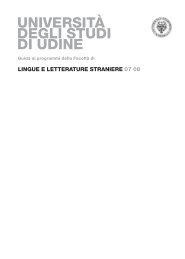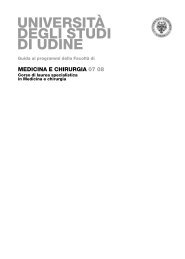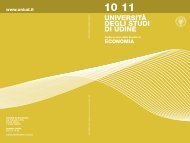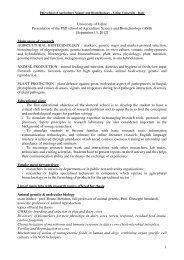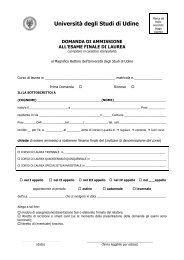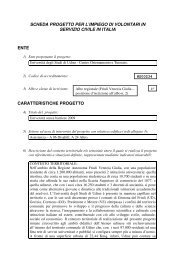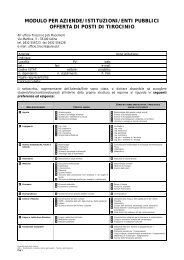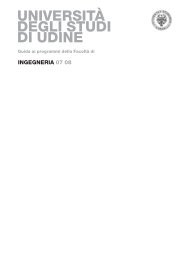â¢GUIDA ECONOMIA 07-08 - Università degli studi di Udine
â¢GUIDA ECONOMIA 07-08 - Università degli studi di Udine
â¢GUIDA ECONOMIA 07-08 - Università degli studi di Udine
Create successful ePaper yourself
Turn your PDF publications into a flip-book with our unique Google optimized e-Paper software.
184 prospectus u<strong>di</strong>ne<br />
house Toolkit: the Complete Guide to<br />
Dimensional Modeling, Hoepli, 2002 (in<br />
English).<br />
- J. HAN, M. KAMBR, Data Mining, Morgan<br />
Kaufman, 2001 (in English).<br />
- I.H. WITTEN, E. FRANK, Data Mining,<br />
Elsevier, 2005 (in English).<br />
Teaching method and examination<br />
16 two-hour lessons; development of a<br />
project in small groups; in<strong>di</strong>vidual final<br />
oral examination.<br />
DATABASE<br />
Prof. Angelo Montanari<br />
Contents<br />
The course aims at acquainting the students<br />
with the basic concepts, methodologies,<br />
and tools developed in the area of<br />
database systems. Special attention will<br />
be devoted to conceptual and logical data<br />
models and to database languages for<br />
data definition, update and query processing.<br />
Moreover, we will introduce the<br />
basic techniques and methodologies for<br />
conceptual design (synthesis of<br />
Entity/Relationship schemas) and logical<br />
design (translation of Entity/Relationship<br />
schemas into relational schemas) of databases.<br />
Bibliography<br />
Course textbook<br />
- P. ATZENI, S. CERI, S. PARABOSCHI, R.<br />
TORLONE, Basi <strong>di</strong> dati. Modelli e linguaggi<br />
<strong>di</strong> interrogazione, second e<strong>di</strong>tion,<br />
McGraw-Hill, 2006.<br />
Further rea<strong>di</strong>ng<br />
- R. ELMASTRI, S. NAVATHE, Sistemi <strong>di</strong> basi<br />
<strong>di</strong> dati. Fondamenti, forth e<strong>di</strong>tion, Pearson<br />
/ Ad<strong>di</strong>son-Wesley, 2004.<br />
- R. VAN DER LANS, Introduzione a SQL,<br />
second italian e<strong>di</strong>tion, Ad<strong>di</strong>son-Wesley,<br />
2001.<br />
DEMOGRAPHIC MODELS<br />
Prof. Alessio Fornasin<br />
Contents<br />
Demographic phenomena have complex<br />
reciprocal relationships which determine<br />
the population’s growth patterns and its<br />
structural transformations, creating a<br />
demographic system. The course will<br />
introduce the main models that are<br />
endogenous to the demographic system.<br />
Some elementary models of population<br />
development in the presence of economic,<br />
resource and environmental constraints<br />
will be illustrated. A large amount<br />
of time will be de<strong>di</strong>cated to the theoretical<br />
para<strong>di</strong>gms underlying the various models,<br />
and to their empirical application.<br />
Particular attention will be given to forecast<br />
models and to survival analysis. Practical<br />
lessons using the principal demographic<br />
software have been scheduled in<br />
the IT room.<br />
Bibliography<br />
Class notes and textbooks will be recommended<br />
during the course.<br />
DYNAMICAL METHODS<br />
FOR ECONOMICS 1<br />
Prof. Alfredo Me<strong>di</strong>o<br />
Aims<br />
The main purpose of this course is to<br />
acquaint the students with the systematic<br />
analysis of dynamical models in economics,<br />
inclu<strong>di</strong>ng the use of computational<br />
and graphical methods.<br />
Contents<br />
In Part 1, the lecturer will introduce some<br />
fundamental concepts of dynamical system<br />
theory, making use of simple models<br />
in <strong>di</strong>screte time, represented mathematically<br />
by systems of one or two <strong>di</strong>fference<br />
equations. The <strong>di</strong>fferent types of dynamical<br />
behaviour of those systems (e.g., fixed



